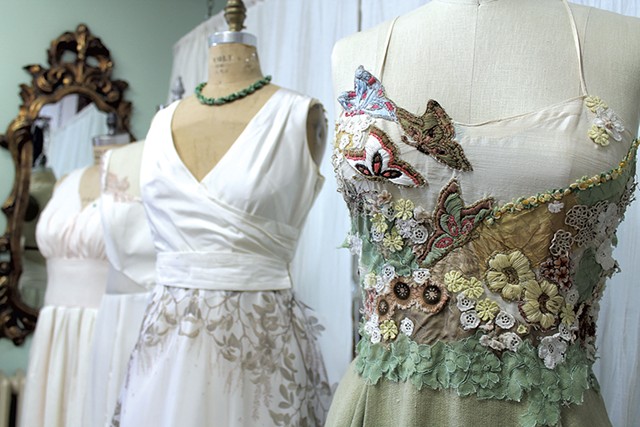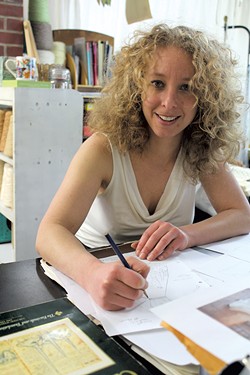
- Julia Shipley
- Tara Lynn Scheidet dresses
When eco-couture designer Tara Lynn Scheidet boasts, "Each dress has a story," she means it has a fairy tale. Like the one in which bride-to-be Kellee Wagner and her mother lit out across the Adirondacks, ferried over the lake and rambled through the forests of Vermont's Northeast Kingdom to reach Scheidet's bridal studio in Sutton. Bearing with them an old dress and a tablecloth, they asked her: Could she alchemize these materials into a wedding gown?
Scheidet has a degree from the Fashion Institute of Technology and a client roster that includes a previous Miss Vermont — in 2008, she made Ashley Wheeler's gown for the Miss America pageant. The designer also has a thing for nature. At her studio, Tara Lynn Bridal, she makes bespoke dresses from earth-friendly organic cotton, linen, silk and hemp blends.
Examining the materials those upstate New York clients brought to her studio, Scheidet went to work. "I grabbed some chiffon and layered it across the dressmaker's dummy," she said in a recent interview. Next, she added a drapery made from the tablecloth, which featured hand-embroidered dahlias and daisies. Some pins here, a tuck there. Suddenly, the bottom of the old dress became the lining for the new, and — voilà — the bride-to-be saw the promise of her future wedding gown.
Scheidet's start as an eco-designer also has elements of a Cinderella story. Seventeen years ago, increasingly concerned about the "dark side" of fashion — sweatshops, toxic chemicals and dyes — she abandoned New York City, moved to Vermont and launched her company. Using her needle like a magic wand, she's been making one-of-a-kind gowns ever since.
The granddaughter of an upholsterer (who uses her grandfather's shears), Scheidet grew up in Setauket, Long Island. She started out designing couture outfits for herself; in junior high, she recalled, she took apart her mom's bellbottoms and made a skirt and jacket. The latter, she admitted with a laugh, was a little snug: "You couldn't hug anybody with the jacket on."
All through high school, she continued to "make something out of something." She would spend her evenings whipping up unique creations, Scheidet said, and fellow students greeted her the next morning at the bus stop with benign curiosity. The hard part, she remembered, was walking the school's long corridor — her runway of sorts — where she was sure to elicit unwelcome comments or stares from members of student cliques.
Perhaps that scrutiny intensified Scheidet's fashion resolve. When her parents strongly encouraged her to study law, she made — and won — a case for attending FIT instead.
By her second year in fashion school, however, Scheidet had become disenchanted with the industry. "It's wasteful; it's full of toxic chemicals that make people sick, all because we want to wear clothes," she said. She considered leaving to study environmental law at Vermont Law School, but this time her parents stood firm, telling her to finish what she'd started.
So, while still enrolled, Scheidet began to search for natural materials. That led her to a job at a store that sold hemp apparel in Hell's Kitchen, where she sometimes took on extra work custom-designing hemp clothing. She created six pairs of pajamas for one client; she made another a linen suit.
In 1999, Scheidet sewed her first wedding gown, which featured a detachable train of seashells held together with macramé knots of hemp thread. She designed the groom's garb, as well, embroidering along his shirt's button placket the symbols for peace, water, rain, sun, the earth and the astrological signs Capricorn and Taurus. The design told an elemental story of the couple's union.
Inspired by a visit to Bread and Puppet Theater in nearby Glover when she was in seventh grade, Scheidet had grown up with plans to move to Vermont. In 2000, after her graduation from FIT, she and then-boyfriend (now husband) Evan Scheidet purchased a 92-acre property in the Northeast Kingdom bounded by U.S. Route 5 and the Sutton River.
By 2001, she and Evan, a mechanic and machinist, had moved into a log cabin on their land, where they lived without electricity or water, save for the buckets they carried up from the river. In 2003, they got married in their back yard. Today, the dress Scheidet made for her own nuptials is among several showcased at Tara Lynn Bridal.
Over the years, Scheidet pieced together several jobs: She taught fashion design at Bennington College, created hats for Turtle Fur in Morrisville, and worked as an assistant designer at Garnet Hill in Franconia, N.H., sketching out sweaters and pajamas. All the while, she continued to stitch together her own business.

- Julia Shipley
- Tara Lynn Scheidet
In her spacious, solar-powered studio, Scheidet created a collection of 20 dresses that brides can order by size, ranging in price from $800 to $2,500. She has also designed more than 100 "sky's the limit" custom gowns, which start at $15,000. Drawing inspiration from vintage fabric scraps and field guides to butterflies, flowers and birds, Scheidet has become a sort of fairy godmother with needle and thread. Her creations hold special appeal for ecologically concerned brides and grooms seeking to express their love with unique apparel — and sometimes on it.
Take the woman who insisted on having a trout on her skirt. When fish appliqués failed to please, Scheidet hand-painted the inner panels of the dress. As the bride swished down the aisle, onlookers saw flashes of speckled trout peeking from the pleats. The vision touched the bride's father, who had taught her to fly-fish as a little girl.
Clients tend to find Scheidet as refreshing as they do her clothing. Laura Hinds, a Philadelphia-based social worker, said via email that she'd been overwhelmed by "over-the-top coercion from bridal stylists to purchase their dresses." Then she learned about natural-fiber dresses, repurposed fabrics and environmentally friendly processes at an alternative bridal expo.
"It was important to me that our ceremony celebrating love not hurt our environment," Hinds said. Searching for a seamstress with "earth-respecting processes," she found Tara Lynn Bridal.
For the same reasons, Shannon Griffin also chose to have a dress made rather than purchase one at a store. In an email, the Australia-based chef said she had become "concerned with the effects of my choices in the food world. What we choose to put on a menu has far-reaching effects in people's everyday lives somewhere in the world." She applied the same principles to sourcing her wedding gown.
In addition to supplying their measurements, brides send Scheidet pictures of themselves — front, side and full-length back views — wearing something fitted, such as yoga clothes. They also provide thoughtful answers to the designer's queries, such as "Tell me about your personality." Scheidet collects information on everything from the bride's budget to her color scheme to her favorite physical features.
Hinds said this process was when the "magic" began for her. "I have a long torso, though a short back and short legs — not the easiest shape to fit," she noted. Hinds sent Scheidet measurements and sketches, mentioning her reverence for dragonflies and their role in her relationship with her fiancée, Leah Hynansky. Together, seamstress and bride discussed how to personalize the gown with designs that were pertinent to the couple's story.
"My [late] grandmother was a big part of my life and couldn't be a living part of our wedding," Hinds recalled, "so I gave Tara Lynn this filmy, sheer garment she used to wear over other shirts." Scheidet turned it into dragonfly wings.
The dress-designing process even helped draw the couple and their extended families together. "It was hard for my mom that I was marrying a woman," Hinds said by phone. "It was through working with Tara Lynn that we started the normalizing process, as I asked my mom to weigh in on the dress fitting and design."
When all three women traveled to Sutton for the fitting, Hinds said, "The dress was almost perfect, just [needed] some slight alterations — all from my measurements and description of my frame!"
That's when Hynansky expressed interest in a gown of her own. In the end it, too, featured hand-embroidered dragonflies.
"We all bonded over this experience," Hinds said.









Comments
Comments are closed.
From 2014-2020, Seven Days allowed readers to comment on all stories posted on our website. While we've appreciated the suggestions and insights, right now Seven Days is prioritizing our core mission — producing high-quality, responsible local journalism — over moderating online debates between readers.
To criticize, correct or praise our reporting, please send us a letter to the editor or send us a tip. We’ll check it out and report the results.
Online comments may return when we have better tech tools for managing them. Thanks for reading.